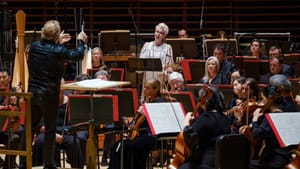Stay in the Loop
BSR publishes on a weekly schedule, with an email newsletter every Wednesday and Thursday morning. There’s no paywall, and subscribing is always free.
A lengthy thrill
Philadelphia Orchestra presents Yannick Nézet-Séguin conducting Mahler’s Third Symphony

Yannick Nézet-Séguin led the Philadelphia Orchestra over the weekend with a multifaceted performance of Gustav Mahler’s Symphony No. 3 in D minor. It was an exciting, sometimes thrilling performance with plenty of innuendo and an adagio that surely brought many in the audience to the verge of tears.
This is not only the longest symphony in the standard repertoire (about an hour and 45 minutes of non-stop glorious music) but also has a palette brighter than a Fauvist’s paintbox. This is just the kind of work Nézet-Séguin likes to sink his teeth into, full of vivid primary colors, exquisite shadings, and complex musical conversations involving the orchestra, three choirs, and guest mezzo-soprano Joyce DiDonato.
Please silence your cell phones
Nézet-Séguin, spiffy in a sleek black jacket, his blond hair swept back, greeted the audience before the performance, reiterating the importance of turning off cell phones, even offering a cheerful lesson on how to make sure the right buttons were pushed. He was no doubt thinking of the intimacy and pathos of the final movement, which could be crushed by an intrusive ringtone. This is not a minor issue since music unfolds in the context of silence, and an uninvited siren or ring is a death knell for musical art. The conductor’s approach worked except for one fraction of a second when a rogue phone began to ring almost exactly at the same time as the chorus high above the stage of Marian Anderson Hall rose with an energetic (and fortunately loud) “Bimm, bamm!”
An explosion of sound
The program proceeded through the symphony’s six movements with no intermission. Nézet-Séguin tore voraciously into the opening measures, making what was probably too strong a statement. But having been absent from the concert hall for more than half a year, I found the explosion of sound irresistible. Even with advances in technology, there is nothing like the visceral impact of a large symphonic orchestra at full throttle, especially when a large brass section with eight French horns is involved.
Ambition and perfection
Completed in 1896, Mahler’s Third is an ambitious work, tracing the evolution of our possibly peerless planet from the awakening of spring through flowers, animals, humanity, angels, and love. This performance was enhanced by not only the quantity but also the quality of the participating musicians. From the large, broad strokes of the trombones and tuba to the sounds of cheerful forest creatures lurking in woodwind and percussion passages, Nézet-Séguin enhanced a rich variety of musical textures through his skillful leadership.
This was especially clear at the several points in which the solo trumpet cut through the tumult of the orchestra tutti. Excellent playing by new Principal Trumpet Esteban Batallán, who also played the post-horn off-stage in the third movement. Quick snippets of perfection bubbled up here and there, such as a brief pas de deux by harp and cymbals about a half hour into the production.
Pure radiance
In dazzling white, but barely visible in the back of the orchestra, DiDonato sang from Nietzsche’s text, Also Sprach Zarathustra, in the fourth movement (still Mahler’s music, not the Richard Strauss tone poem). The children’s choir and soprano and alto choir supported her interpretation of a text titled Three Angels Sang in the fifth movement. The soloist’s voice—so liquid, so clear—illuminated the text and made me wonder why Mahler had not included additional measures for mezzo, soprano and alto, and children’s choir. What’s another 10 minutes among friends?
But it was in the finale that one understood just how far Nézet-Séguin has come in his past dozen years as musical director. In those concluding passages, conductor and audience merged in moments of pure radiance, a stasis only an accomplished musician and receptive audience can achieve. Thank you, Nézet-Séguin and friends, for an experience not soon to be forgotten.
What, When, Where
Mahler’s Symphony No. 3 in D minor. Conducted by Yannick Nézet-Séguin. Joyce DiDonato, mezzo-soprano; sopranos and altos of the Philadelphia Symphonic Choir, directed by Joe Miller; Philadelphia Boys Choir, directed by Jeffrey R. Smith; Philadelphia Girls Choir, directed by Nathan Wadley. Philadelphia Orchestra. October 3, 4, and 5, 2024, at the Kimmel Cultural Campus’s Marian Anderson Hall, 300 S Broad Street, Philadelphia. (215) 893-1999 or philorch.org.
Accessibility
The Kimmel Cultural Campus is an ADA-compliant venue. Patrons can purchase wheelchair seating or loose chairs online by calling (215) 893-1999 or emailing patron services. With advance notice, patron services can provide options for personal care attendants, American Sign Language, Braille tickets and programs, audio descriptions, and other services.
Masks are not required in Kimmel venues.
Sign up for our newsletter
All of the week's new articles, all in one place. Sign up for the free weekly BSR newsletters, and don't miss a conversation.

 Linda Holt
Linda Holt